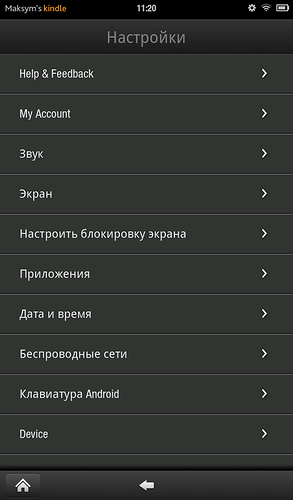Amazon Kindle Fire - partial Russification
 Just yesterday, a courier called me and informed me of the parcel from the states. The long-awaited Fire came, after a month of waiting for pre-order. We omit all the difficulties of ordering and delivery to Ukraine, because The tablet is already sold in many domestic online stores.
Just yesterday, a courier called me and informed me of the parcel from the states. The long-awaited Fire came, after a month of waiting for pre-order. We omit all the difficulties of ordering and delivery to Ukraine, because The tablet is already sold in many domestic online stores. I’ll warn you right away that for me this is the first tablet and the first Android device. So there will be many, at first glance, commonplace things.
I won’t say anything special about native firmware, because there are already a bunch of reviews on youtube about it. Let's move on to the most interesting, namely:
Obtaining root access;
Installing a Russian keyboard (in the standard delivery there is no way to change the layout);
Installing the Android market (optional in the next article).
Obtaining root access on Amazon Kindle Fire
Step One: Download and install the Android SDK . You may need the JDK, but the installer will tell you where to get it. In the SDK you need to install Android 2.3.3 (API10) and the Google USB Driver Package.
Step Two: We go to the folder % Users% /% Username% /. Android (for Windows 7). We find the adb_usb.ini file there and write it at the very end 0x1949 . After that, go to the folder in which we installed the SDK, find android_winusb.inf ( \ extra \ google \ usb_driver \ ) there, add the following text to the [Google.NTx86] and [GoogleNTamd64] sections : Step three:
;Kindle Fire
%SingleAdbInterface% = USB_Install, USB\VID_1949&PID_0006
%CompositeAdbInterface% = USB_Install, USB\VID_1949&PID_0006&MI_01
We connect the tablet and feed the Windows patched inf.
Step Four: Download Super One Click from shortfuse.org - I used version 2.2.
Step Five: Launch Super One Click and click Root. After several manipulations, the program will kill you a tablet.
On this, it seems like everything, but for some reason, Superuser did not appear for me. The problem was solved quite simply ...
We go to the tablet settings, then Device, and allow installation from unfamiliar sources (Allow Instalation of Applications From Unknow Sources). Next, in the built-in browser, we type root explorer apk (the amateur application is the first thing I found). Download, install and run. We go to the System \ App folder and launch the Superuser.apk application there.
Voila - applications can now gain root access to the system.
Installing a Russian keyboard and locale on Amazon Kindle Fire
In principle, when I bought Fire, I did not expect to see Russian localization, but the hope of seeing the possibility of switching to the Russian layout died at the moment when the tablet already fell into my hands.
But having root access, changing the default keyboard does not present any problem.
To get started, download a keyboard that supports keyboard layout changes. Again, in the native Amazon Market you will not find such joy, but a little googling I found Hacker's keybord apk. Unfortunately, nothing happened after installing apk, as there was a default application without changing the layout - it remained. There is no way to change the keyboard application by simply changing the settings.
To install the keyboard with the ability to change the layout, we need:
- Amazoon Kindle Fire with root access;
- The program on the tablet WiFi Transport (available in the Amazon market);
- The program on the tablet Root Explorer (where to get, see above);
- the SQLite ;
- Hacker's keyboard apk .

Having installed the above programs, we will begin Russification.
Step One: Run Root Explorer, go to the /data/data/com.android.providers.settings/databases folder
and copy the settings.db file to the clipboard. Then go to the / sdcard / download folder and paste it there.
Step two: Launch WiFi Transport and connect via ftp to the tablet and copy the settings.db file to the computer.
Step Three: Having saved, first, a copy of settings.db in a safe place, we proceed to editing using SQLite. We go to the Browse Data tab, select the secure table. We need fields with the name enable_input_methods and default_input_method . By default there will be com.android.inputmethod.latin / .LatinIME. For Hacker's Keyboard, change the values to org.pocketworkstation.pckeyboard / .LatinIME . Save the file and upload it back to the tablet.
Here is another list of values for different keyboards (taken from xda): Step Four: Using the same Root Explorer, copy the changed settings.db file to the /data/data/com.android.providers.settings/databases folder . Then we set him the attributes rw-rw ---- (if you don’t do this, get a brick). Step Five - Change the locale to Russian: Download the MoreLocale 2 program . Having installed it, without special gestures, you can change the locale to Russian. Step six: Reboot the tablet and get the Russian keyboard and partially Russified interface.
Swiftkey (платная версия): com.touchtype.swiftkey/com.touchtype.KeyboardService
Swiftkey Tablet (платная версия): com.touchtype.swiftkey.tablet.full/com.touchtype.KeyboardService
Swype: com.swype.android.inputmethod/.SwypeInputMethod
SymbolsKeyboard & TextArt Pro: com.mobisters.textart.pro/.AsciiTextArtKeyboardPro
SlideIT: com.dasur.slideit/.SlideITIME
Graffiti Pro: com.access_company.graffiti_pro/.Graffiti
FlexT9: com.nuance.flext9.input/.IME
Beansoft Thumb Keyboard: com.beansoft.keyboardplus/.LatinIME
Hacker's Keyboard: org.pocketworkstation.pckeyboard/.LatinIME
Simeji: com.adamrocker.android.input.simeji/.OpenWnnSimeji

PS I express my sincere gratitude to the xda developers forum .
PPS If something does not work out - write, I will help to figure it out if possible.
UPD: In some cases, after rebooting the tablet, you can get a brick - the download freezes on the logo. Hard reset can help - hold the power button for about 20 seconds. If it does not help, see this instruction .
